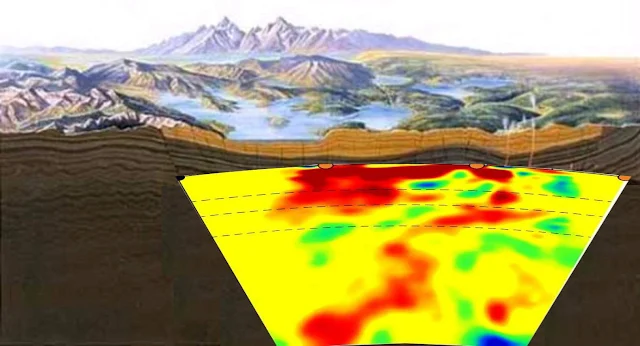New Evidence for Plume Beneath Yellowstone National Park
 |
| Depth cross-section through the plume structure showing its connection with the Yellowstone hotspot. |
A pair of researchers from the University of Texas has found what they claim is evidence of a plume beneath Yellowstone National Park. In their paper published in the journal Nature Geoscience, Stephen Grand and Peter Nelson further propose that the plume is part of a zone that runs to the park all the way from Mexico.
The Yellowstone hotspot, located in North America, is an intraplate source of magmatism the cause of which is hotly debated. Some argue that a deep mantle plume sourced at the base of the mantle supplies the heat beneath Yellowstone, whereas others claim shallower subduction or lithospheric-related processes can explain the anomalous magmatism.
A plume is a still theoretical abnormality that lies at the boundary between the Earth's core and the mantle, and rises through the mantle into the crust—an abnormality that would exist as a vertical stream of magma.
As the researchers note, the prospect of a plume beneath Yellowstone has been strongly debated—some have suggested a plume would explain the source of the heat that drives so much surface activity in the park.
The researchers found what they describe as "a long, thin, sloping zone" (approximately 72 by 55 kilometers in size) inside of the mantle where seismic waves were traveling slower than the areas around them—this suggests a section of the mantle that is approximately 600 to 800° C degrees warmer than surrounding areas, and offers strong evidence of a plume.
They conclude by suggesting that there is likely a thin plume stretching from the core-mantle boundary beneath the park and that it is responsible for the volcanism seen at Yellowstone. But they also acknowledge that more research is required because there are still questions regarding how Yellowstone exists in its current location. They theorize that it is possible because the plume is held steady by a part of the Pacific large low-shear-velocity province.
They finish by suggesting that current methods used by other researchers to study plumes may not be adequate because global tomography is not capable of capturing thin thermal plumes such as the one they suggest lies beneath Yellowstone.
See also: Yellowstone Magma Much Bigger Than Thought
The study was published in the journal Nature Geoscience.

%20(1).webp)






